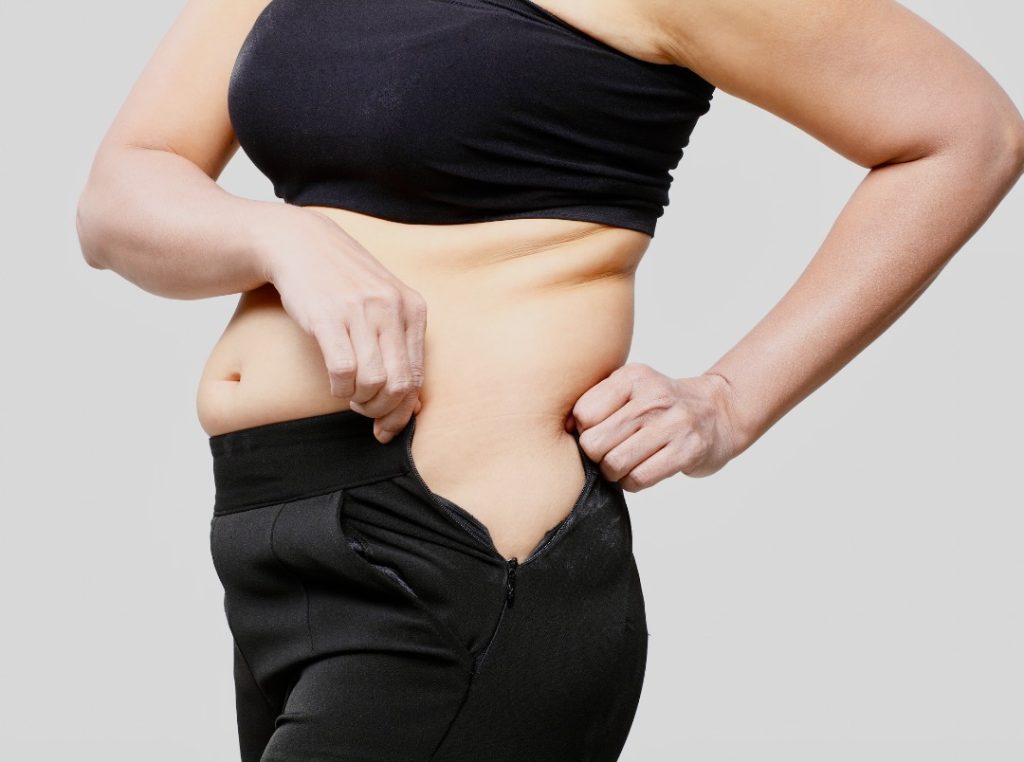Perimenopause—the transitional phase before menopause—typically begins in a woman’s mid-40s but can start as early as the mid-30s. This stage is marked by fluctuations in ovarian function and estrogen levels, leading to various symptoms, including weight gain. Menopause, officially defined as 12 consecutive months without a menstrual period, usually follows 5-7 years later. The onset and experience of menopause can vary based on factors such as genetics, ethnicity, lifestyle, and body composition.
Given that by mid-2023, over 40% of the U.S. population consisted of Millennials (ages 27-42) and Gen X (ages 43-58), a significant percentage of American women are either experiencing perimenopause or have entered menopause. While many are familiar with common symptoms like hot flashes, night sweats, and mood changes, fewer realize that weight gain can be directly linked to estrogen loss. Unlike some symptoms that fade over time, weight gain during perimenopause requires long-term management.
How Estrogen Influences Appetite and Weight
Throughout a woman’s reproductive years, estrogen plays a key role in regulating appetite, metabolism, and energy balance. During the luteal phase of the menstrual cycle, when estrogen levels drop, food intake naturally increases by about 200 calories per day, often with a preference for sweet foods. As estrogen levels decline during perimenopause, similar appetite increases occur, coupled with a decrease in energy expenditure. As a result, up to 70% of women gain weight during this transition (Hallam et al., 2016).
The average weight gain during perimenopause is approximately 3.3 pounds (1.5 kg) per year, with a total accumulation of around 22 pounds (10 kg) by the time menopause is reached (Denby, 2023). This weight gain is not just a cosmetic concern—it has significant implications for overall health.
Changes in Body Composition
Perimenopause is associated with shifts in body composition. Women tend to accumulate more fat, particularly in the abdominal region, where visceral fat increases from 5-8% of total body weight to 10-15%. At the same time, lean body mass, including muscle and bone, declines due to hormonal changes. This reduction in muscle mass slows metabolic rate, making weight management even more challenging (Muscogiuri et al., 2024).
These changes also elevate the risk of metabolic disorders, including:
- Type 2 diabetes
- Dyslipidemia (abnormal cholesterol levels)
- Metabolic dysfunction-associated steatotic liver disease (MASLD)
- Cardiovascular disease
- Osteoporosis and sarcopenia (age-related muscle loss)
Additionally, symptoms like poor sleep, night sweats, and fatigue can reduce physical activity, further contributing to weight gain.
Strategies for Managing Weight During Perimenopause and Menopause
Hormone Replacement Therapy (HRT)
Hormone therapy can help mitigate some of the metabolic effects of estrogen loss. Studies have shown that HRT can:
- Reduce visceral fat and overall BMI
- Increase lean muscle mass
- Improve insulin sensitivity and lipid profiles
- Lower the risk of cardiovascular disease
- Enhance sleep quality and energy levels, making it easier to maintain an active lifestyle
Dietary Adjustments
For women who cannot or choose not to use HT, reducing calorie intake can be an effective strategy. Research suggests that women in their 50s need to consume about 200 fewer calories per day than they did in their 30s and 40s to prevent weight gain (Mayo Clinic Staff, 2023). Prioritizing protein intake while minimizing excessive fats and carbohydrates can also help preserve muscle mass and prevent fat accumulation.
Activating GLP-1 to Support Appetite Control
One innovative approach to managing appetite during perimenopause is the use of Amarasate®, a natural extract from hops flowers grown in New Zealand. This compound stimulates bitter taste receptors in the gut, triggering the release of glucagon-like peptide-1 (GLP-1), a hormone that promotes satiety and slows gastric emptying.
Calocurb®, a supplement containing Amarasate®, has been extensively researched, with findings showing:
- A doubling of the GLP-1 response when taken before meals
- An 18% reduction in calorie intake at the next meal (Walker et al., 2022)
- A 30% decrease in hunger and a 40% reduction in cravings during fasting periods (Walker et al., 2024)
- A 14% decrease in post-fast meal consumption
For a woman consuming 1,800-2,200 calories per day, a 14% reduction in one meal equates to eliminating 252-308 calories—more than the recommended daily calorie reduction to avoid weight gain during perimenopause.
Safety and Efficacy of Calocurb®
Calocurb® is manufactured using CO2 supercritical extraction in New Zealand and encapsulated in delayed-release Licaps® to ensure targeted delivery beyond the stomach. Clinical studies and case reports indicate minimal side effects, though approximately 5% of users may initially experience mild digestive symptoms such as diarrhea. To minimize discomfort, users are advised to gradually increase their dosage over several days.
Unlike some weight loss medications, Calocurb® does not enter the bloodstream in significant amounts, meaning it does not interfere with liver or kidney metabolism or interact with other medications.
Conclusion
Weight gain during perimenopause is a common and significant health challenge, with potential long-term implications for metabolic and cardiovascular health. By reducing daily caloric intake by approximately 200 calories, Calocurb® offers a natural, effective tool to help women manage their weight more easily during perimenopause and beyond. When combined with healthy lifestyle habits and, when appropriate, hormone therapy, Calocurb® can support women in maintaining their health, energy, and confidence through this life transition.
- Written for Calocurb by _Dr. Tracey Lambert
References
- Gold EB. The timing of the age at which natural menopause occurs. Obstet Gynecol Clin North Am. 2011;38(3):425-440. doi:10.1016/j.ogc.2011.05.002
- Veera Korhonen. U.S. population share by generation 2023. Statista. Published July 5, 2024. Accessed October 27, 2024. U.S. population share by generation 2023 | Statista
- López M, Tena-Sempere M. Estrogens and the control of energy homeostasis: a brain perspective. Trends Endocrinol Metab. 2015;26(8):411-421. doi:10.1016/j.tem.2015.06.003
- Hallam J, Boswell RG, DeVito EE, Kober H. Gender-related differences in food craving and obesity. Yale J Biol Med. 2016;89(2):161-173. Published 2016 Jun 27.
- Dragano N, Milbank E, López M. Estradiol and appetite: To eat or not to eat. Molec Metab. 2020;42:101061. doi:10.1016/j.molmet.2020.101061
- Hurtado MD, Tama E, Fansa S, et al. Weight loss response to semaglutide in postmenopausal women with and without hormone therapy use. Menopause. 2024;31(4):266-274. doi:10.1097/GME.0000000000002310
- Denby N. Menopause: Nutrition and weight gain. British Menopause Society; 2023. https://thebms.org.uk/wp-content/uploads/2023/06/19-BMS-TfC-Menopause-Nutrition-and-Weight-Gain-JUNE2023-A.pdf
- Simpson SJ, Raubenheimer D, Black KI, Conigrave AD. Weight gain during the menopause transition: Evidence for a mechanism dependent on protein leverage_. BJOG_. 2022;130(1):4-10. doi: OBGYN
- Muscogiuri G, Verde L, Vetrani C, Barrea L, Savastano S, Colao A. Obesity: A gender-view. J Endocrinol Invest. 2024;47 (2):299-306. doi:https://doi.org/10.1007/s40618-023-02196-z
- Mayo Clinic Staff. The reality of menopause weight gain. Mayo Clinic. Published July 8, 2023. Accessed October 27, 2024. The reality of menopause weight gain
- Walker EG, Lo KR, Pahl MC, et al. An extract of hops (Humulus lupulus L.) modulates gut peptide hormone secretion and reduces energy intake in healthy-weight men: a randomized, crossover clinical trial. Am J Clin Nutr. 2022;115(3):925-940. doi: https://doi.org/10.1093/ajcn/nqab418
- Walker E, Lo K, Gopal P. Gastrointestinal delivery of bitter hop extract reduces appetite and food cravings in healthy adult women undergoing acute fasting. Obes Pillars. 2024;11:100117. Published 2024 Jun 20. doi:10.1016/j.obpill.2024.100117

